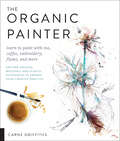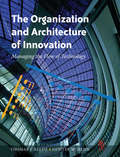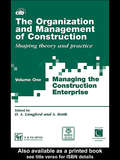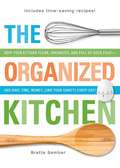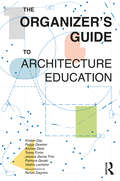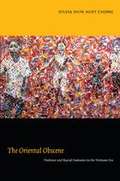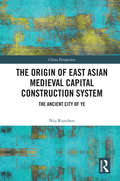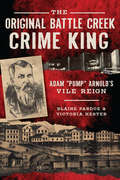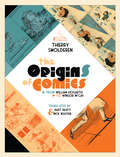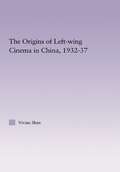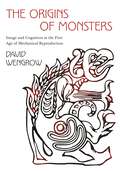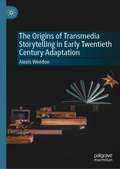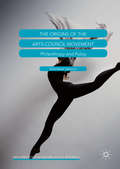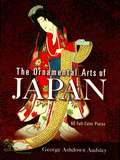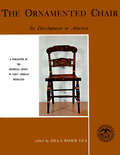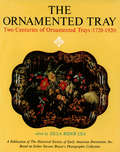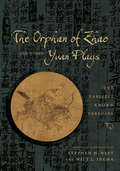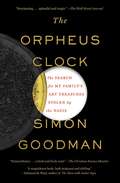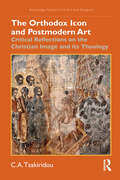- Table View
- List View
The Organic Lunchbox: 125 Yummy, Quick, and Healthy Recipes for Kids
by Marie W. LawrenceTaking the mystery out of making nutritious meals that your kids will love, The Organic Lunchbox has a variety of options that are sure to tantalize even the most finicky taste buds. Divided into categories, including Breakfast for Lunch, Hot or Cold, Vegetables on Parade, Soups and Sandwiches, and Something Not Too Sweet, you’ll find fun and often finger-friendly fare such as: Classic mini pizzasBroccoli cheese soupSweet potato chipsCrunchy French toast fingersMeatloaf cupcakesLemon-lime gel with blueberriesThe easy-to-follow recipes, many of which are geared to kid- or family-friendly preparation, will include peanut-free and tree nut-free options. In addition, The Organic Lunchbox will include information on purchasing and utilizing organic ingredients and tips on which types of food are most important to consider when looking for the organic designation. Lawrence also offers helpful suggestions for making kid-size portions, serving options, and storing until they’re ready to be packed into a lunchbox.
The Organic Painter: Learn to Paint with Tea, Coffee, Embroidery, Flame, and More
by Carne GriffithsFind new creative possibilities with unconventional media—using innovative techniques to turn everyday materials into non-traditional, natural “paints.”Traditional art supplies will only take you so far! Sometimes you need to try something completely new and different. With the guidance in The Organic Painter, you’ll soon be painting with everyday materials you’d never considered as an artistic medium.This inspiring book gives you all the techniques and ideas you’ll need to boost your creativity, learn natural paint-making, and be more resourceful with your art materials. Imagine the unique things you’ll make when you create natural paints from coffee, tea, embroidery thread, flame, and more.Each project in this guidebook comes with instructions on how to make the paint, and also includes experiments and explorations for you to try. Plus, a simple painting accompanies every featured material and combines it with other materials or techniques—so you’ll never lack inspiration.
The Organization and Architecture of Innovation
by Thomas Allen Gunter HennBuilding on his pioneering work on the management of technology and innovation in his first book, Managing the Flow of Technology, Thomas J. Allen of MIT has joined with award-winning German architect Gunter Henn of HENN Architekten to produce a book that explores the combined use of two management tools to make the innovation process most effective: organizational structure and physical space. They present research demonstrating how organizational structure and physical space each affect communication among people—in this case, engineers, scientists, and others in technical organizations—and they illustrate how organizations can transform both to increase the transfer of technical knowledge and maximize the “communication for inspiration” that is central to the innovation process. Allen and Henn illustrate their points with discussions of well-known buildings around the world, including Audi’s corporate headquarters, Steelcase’s corporate design center, and the Corning Glass Becker building, as well as several of Gunter Henn’s own projects, including the Skoda automotive factory in the Czech Republic and the Faculty for Mechanical Engineering at the Technical University of Munich. Allen and Henn then demonstrate the principles developed in their work by discussing in detail one example in which organizational structure and physical space were combined successfully to promote innovation with impressive results: HENN Architekten’s Project House for the BMW Group Research and Innovation Centre in Munich, cited by Business Week (April 24, 2006) in naming BMW one of the world’s most innovative companies.Professor Thomas Allen is the originator of the Allen curve. In the late 1970s, Tom Allen undertook a project to determine how the distance between engineers’ offices coincided with the level of regular technical communication between them. The results of that research, now known as the Allen Curve, revealed a distinct correlation between distance and frequency of communication (i.e. the more distance there is between people — 50 meters or more to be exact — the less they will communicate). This principle has been incorporated into forward-thinking commercial design ever since, in, for example, The Decker Engineering Building in New York, the Steelcase Corporate Development Center in Michigan, and BMW’s Research Center in Germany.
The Organization and Management of Construction: Managing construction information
by D. A. Langford A. RetikThe proceedings of the CIB W65 Symposium on the Organization and Management of Construction conference are presented here and in the companion volumes as state-of-the-art papers documenting research and innovative practice in the field of construction.The volumes cover four broad themes: business management, project management, risk management, IT development and applications. Each volume is organized to provide easy reference so that the practitioner can speedily extract up to date information and knowledge about the global construction industry. Managing the Construction Enterprise (Volume One): Covers the firm and its business environment, markets and marketing, human resource management strategic planning, and quality management.Managing the Construction Project (Volume Two): focuses upon productivity, procurement, international projects and human issues in relation to management performance of construction organisations.Managing Risk (Volume Two): incorporates discussion of risk away from regulation by government and those safety risks inherent in the construction process.Managing Construction Information (Volume Three, published in conjunction with Construct IT Centre of Excellence): incorporates material on information systems and methods, application of IT to the design and construction processes and how IT theory and applications are best transmitted to students and practitioners.The work represents a collation of wide ranging ideas and theory about construction and how research has contributed to the development of the industry on a global application of research to the problems of the construction industry.
The Organization and Management of Construction: Managing the construction enterprise
by D. A. Langford A. RetikThe proceedings of the CIB W65 Symposium on the Organization and Management of Construction conference are presented here and in the companion volumes as state-of-the-art papers documenting research and innovative practice in the field of construction. The volumes cover four broad themes: business management, project management, risk management, IT development and applications. Each volume is organized to provide easy reference so that the practitioner can speedily extract up to date information and knowledge about the global construction industry. Managing the Construction Enterprise (Volume One): Covers the firm and its business environment, markets and marketing, human resource management strategic planning, and quality management. Managing the Construction Project (Volume Two): focuses upon productivity, procurement, international projects and human issues in relation to management performance of construction organisations. Managing Risk (Volume Two): incorporates discussion of risk away from regulation by government and those safety risks inherent in the construction process. Managing Construction Information (Volume Three, published in conjunction with Construct IT Centre of Excellence): incorporates material on information systems and methods, application of IT to the design and construction processes and how IT theory and applications are best transmitted to students and practitioners. The work represents a collation of wide ranging ideas and theory about construction and how research has contributed to the development of the industry on a global application of research to the problems of the construction industry.
The Organization and Management of Construction: Shaping theory and practice
by D. A. Langford A. RetikThe proceedings of the CIB W65 Symposium on the Organization and Management of Construction conference are presented here and in the companion volumes as state-of-the-art papers documenting research and innovative practice in the field of construction. The volumes cover four broad themes: business management, project management, risk management, IT development and applications. Each volume is organized to provide easy reference so that the practitioner can speedily extract up to date information and knowledge about the global construction industry. Managing the Construction Enterprise (Volume One): Covers the firm and its business environment, markets and marketing, human resource management strategic planning, and quality management. Managing the Construction Project (Volume Two): focuses upon productivity, procurement, international projects and human issues in relation to management performance of construction organisations. Managing Risk (Volume Two): incorporates discussion of risk away from regulation by government and those safety risks inherent in the construction process. Managing Construction Information (Volume Three, published in conjunction with Construct IT Centre of Excellence): incorporates material on information systems and methods, application of IT to the design and construction processes and how IT theory and applications are best transmitted to students and practitioners. The work represents a collation of wide ranging ideas and theory about construction and how research has contributed to the development of the industry on a global application of research to the problems of the construction industry.
The Organized Kitchen: Keep Your Kitchen Clean, Organized, and Full of Good Food—and Save Time, Money, (and Your Sanity) Every Day!
by Brette SemberAn organized kitchen is the salvation every busy cook needs! You'll save yourself time, money, and stress-all while whipping up delicious, healthy meals your family and friends will love.From aprons to zesters, this book provides an A-Z of simple shortcuts that will make all the difference, including:Shelf and storage strategiesFive-minute kitchen feng shuiWhen to clean what-with whatThe right tools for the right tasksThe truth about freezing foodMeal plans that really workTen foolproof, must-know recipes-with endless variationsThe good-enough stocked pantryLeftovers you'll really want to eatWith tips and tricks from master chefs (think Julia Child's pegboard) and real-life home chefs (think Grandma's ingenious pasta pots), this is the only kitchen/food/life organizer you need to streamline your kitchen-once and for all!The Organized Kitchen: Because you can minimize cooking time and maximize good taste!
The Organizer’s Guide to Architecture Education
by Peggy Deamer Kirsten Day Andrea Dietz Tessa Forde Jessica Garcia Fritz Palmyra Geraki Valérie LechêneThe Organizer’s Guide to Architecture Education serves as a timely call-to-action for transforming architecture education to meet the monumental environmental and social challenges of our time.Written by a collective of eight educators, practitioners, and organizers and structured in three parts, the book considers organizing across four scales of architecture education and reorients architecture toward stewarding the planetary commons. It speaks to students, faculty, and administrators in architecture schools, as well as professional architects and built environment practitioners, who recognize the need to expand and decenter the discipline. Readers will gain critical understandings and skills for reimagining architectural pedagogy, practice, and relations to power structures. Empowered by this knowledge, readers will be motivated to contribute actively to and drive systemic change within the field.Illuminated with how-to methods—from power mapping to conversation tactics—and case study precedents, the book catalyzes a collective redefinition of architecture as a vital player in building a socially just and ecologically regenerative future.
The Oriental Obscene: Violence and Racial Fantasies in the Vietnam Era
by Sylvia Shin ChongThe Oriental Obscene is a sophisticated analysis of Americans' reactions to visual representations of the Vietnam War, such as the photograph of the "napalm girl," news footage of the Tet Offensive, and feature films from The Deer Hunter to Rambo: First Blood Part II. Sylvia Shin Huey Chong combines psychoanalytic and film theories with U.S. cultural history to explain what she terms the oriental obscene: racialized fantasies that Americans derived largely from images of Asians as the perpetrators or victims of extreme violence. Chong contends that these fantasies helped Americans to process the trauma of the Vietnam War, as well as the growth of the Asian American population after the Immigration and Nationality Act of 1965 and the postwar immigration of Southeast Asian refugees. The oriental obscene animated a wide range of political narratives, not only the movements for and against the war, but causes as diverse as the Black Power movement, law-and-order conservatism, second-wave feminism, and the nascent Asian American movement. During the Vietnam era, pictures of Asian bodies were used to make sense of race, violence, and America's identity at home and abroad.
The Origin of East Asian Medieval Capital Construction System: The Ancient City of Ye (China Perspectives)
by Niu RunzhenYe is a historical Chinese city built in 659 BC and burned down to the ground in AD 580. The book investigates the characteristics of the city’s layout and its deep influence on the urban construction in East Asia since the 6th century AD.By studying archaeological findings and historical documents, the author illustrates the historical significance of Ye city, both as capital for six dynasties over 370 years of ancient Chinese history and as a paragon of East Asian capital planning. Ye serves as an exemplary model for famous capitals in later dynasties of imperial China, such as Beijing and Xi’an. Its influence also extends to other East Asian capitals, including Seoul in Korea, Kyoto in Japan, and Hanoi in Vietnam. Comparing the archetypical structure of Ye city and the features of its East Asian descendants, the author encapsulates the lineage of capital city development across medieval East Asia and uncovers a philosophy of constriction that rests upon traditional Chinese thinking.The book will be an essential read for scholars and general readers interested in East Asian heritage, urbanology, and architecture, as well as a useful reference for urban planners willing to learn from historical experience.
The Original Battle Creek Crime King: Adam “Pump” Arnold’s Vile Reign (True Crime)
by Blaine Pardoe Victoria HesterAdam "Pump" Arnold was both feared and regaled in Victorian- era Battle Creek. He was a bootlegger and a pimp, a robber and a con artist, an arsonist and a loan shark and even an assassin. Arnold faced off with the city over illegal liquor sales and flaunted his victory with a life-size statue of the mayor dressed as a hobo. Called the "greatest criminal in the history of Battle Creek," Arnold was convicted in a captivating public trial for the murder of his own son. Join authors Blaine Pardoe and Victoria Hester as they explore the life and misdeeds of the unabashed criminal mastermind who rocked Battle Creek to its core.
The Origins of Comics: From William Hogarth to Winsor McCay
by Thierry SmolderenIn The Origins of Comics: From William Hogarth to Winsor McCay, Thierry Smolderen presents a cultural landscape whose narrative differs in many ways from those presented by other historians of the comic strip. Rather than beginning his inquiry with the popularly accepted "sequential art" definition of the comic strip, Smolderen instead wishes to engage with the historical dimensions that inform that definition. His goal is to understand the processes that led to the twentieth-century comic strip, the highly recognizable species of picture stories that he sees crystallizing around 1900 in the United States. Featuring close readings of the picture stories, caricatures, and humoristic illustrations of William Hogarth, Rodolphe Töpffer, Gustave Doré, and their many contemporaries, Smolderen establishes how these artists were immersed in a very old visual culture in which images—satirical images in particular—were deciphered in a way that was often described as hieroglyphical. Across eight chapters, he acutely points out how the effect of the printing press and the mass advent of audiovisual technologies (photography, audio recording, and cinema) at the end of the nineteenth century led to a new twentieth-century visual culture. In tracing this evolution, Smolderen distinguishes himself from other comics historians by following a methodology that explains the present state of the form of comics on the basis of its history, rather than presenting the history of the form on the basis of its present state. This study remaps the history of this influential art form.
The Origins of Leftwing Cinema in China, 1932-37 (East Asia: History, Politics, Sociology and Culture)
by Vivian ShenThis book takes a cultural studies approach to analyze and account for the ways in which related to film, literature, cultural production, ideology, social change and modernity were in raised in the leftwing film movement of the 1930s.
The Origins of Monsters: Image and Cognition in the First Age of Mechanical Reproduction (The Rostovtzeff Lectures #2)
by David WengrowIt has often been claimed that "monsters"--supernatural creatures with bodies composed from multiple species--play a significant part in the thought and imagery of all people from all times. The Origins of Monsters advances an alternative view. Composite figurations are intriguingly rare and isolated in the art of the prehistoric era. Instead it was with the rise of cities, elites, and cosmopolitan trade networks that "monsters" became widespread features of visual production in the ancient world. Showing how these fantastic images originated and how they were transmitted, David Wengrow identifies patterns in the records of human image-making and embarks on a search for connections between mind and culture. Wengrow asks: Can cognitive science explain the potency of such images? Does evolutionary psychology hold a key to understanding the transmission of symbols? How is our making and perception of images influenced by institutions and technologies? Wengrow considers the work of art in the first age of mechanical reproduction, which he locates in the Middle East, where urban life began. Comparing the development and spread of fantastic imagery across a range of prehistoric and ancient societies, including Mesopotamia, Egypt, Greece, and China, he explores how the visual imagination has been shaped by a complex mixture of historical and universal factors. Examining the reasons behind the dissemination of monstrous imagery in ancient states and empires, The Origins of Monsters sheds light on the relationship between culture and cognition.
The Origins of Transmedia Storytelling in Early Twentieth Century Adaptation
by Alexis WeedonThis book explores the significance of professional writers and their role in developing British storytelling in the 1920s and 1930s, and their influence on the poetics of today’s transmedia storytelling. Modern techniques can be traced back to the early twentieth century when film, radio and television provided professional writers with new formats and revenue streams for their fiction. The book explores the contribution of four British authors, household names in their day, who adapted work for film, television and radio. Although celebrities between the wars, Clemence Dane, G.B. Stern, Hugh Walpole and A.E.W Mason have fallen from view. The popular playwright Dane, witty novelist Stern and raconteur Walpole have been marginalised for being German, Jewish, female or gay and Mason’s contribution to film has been overlooked also. It argues that these and other vocational authors should be reassessed for their contribution to new media forms of storytelling. The book makes a significant contribution in the fields of media studies, adaptation studies, and the literary middlebrow.
The Origins of the Arts Council Movement
by Anna Rosser UpchurchThis important new book offers an intellectual history of the 'arts council' policy model, identifying and exploring the ideas embedded in the model and actions of intellectuals, philanthropists and wealthy aesthetes in its establishment in the mid-twentieth century. The book examines the history of arts advocacy for national arts policies in the UK, Canada and the USA, offering an interdisciplinary approach that combines social and intellectual history, political philosophy and literary analysis. The book has much to offer academics, cultural policy and management students, artists, arts managers, arts advocates, cultural policymakers and anyone interested in the history and current moment of public arts funding in the West.
The Orillia Spirit: An Illustrated History of Orillia
by Randy Richmond James A. McgarveyThe history of Orillia, told through the stories of its people, bringing to life the community’s heritage and significance. The Orillia Spirit: Muddling through Canada’s first, and hilarious, experiment with daylight savings time, Mayor “Daylight Bill” Frost had it. Creating his own money and dreaming a drainage ditch would become a tourist attraction, Mayor Ben Johnson had it. Taking his town’s electric company by force, Mayor J.B. Tudhope had it. Inventing early forms of medicare and the first RVs, dreaming of universities and folk festivals, battling for decades over liquor and rinks, ordinary people had it. Something about the place immortalized in Stephen Leacock’s classic Sunshine Sketches of a Little Town has always inspired its people to reach for their dreams. Turn-of-the-twentieth-century leaders coined the phrase “the Orillia Spirit” to describe their drive to make the town a social, moral, and economic leader of Canada. The results have been comic, tragic, and heroic, as shown in this colourful history of Orillia.
The Ornamental Arts of Japan
by George Ashdown AudsleyJapanese art was virtually unknown in the West until the middle of the nineteenth century, when the island nation emerged from 200 years of self-imposed isolation. A passion for Japanese culture swept Europe, and this landmark publication opened the eyes of the world to the grace and beauty of Japanese design.George Ashdown Audsley, a leader in the revival of English decorative design and one of the first Britons to specialize in Japanese art, assembled this outstanding collection. Featuring 60 full-color plates, it offers spectacular examples of Japanese painting, printing, embroidery, lacquer work, and cloisonné as well as masterpieces in ivory and porcelain. Informative captions accompany each illustration. Art lovers, rare book collectors, and enthusiasts of Japanese culture will treasure this magnificent selection of timeless art.
The Ornamented Chair
by Zilla Rider LeaDiscriminating decorators and collectors, no less than dealers and researchers in antiques, have long felt the need of a comprehensive study of the ornamented chair and its development in America. This book is the product of an effort to satisfy that need and at the same time to bring new pleasures to lovers of beautiful furniture.The book is based on photographic and research material collected by the late Esther Stevens Brazer, who spent a lifetime in the study and revival of early American decoration.The authors are all qualified researchers, teachers, and decorators. In their text they present a general history of chair types, facts regarding ornamentation, and informative accounts of some of the leading craftsmen and decorators of the various periods. The final chapter of the book briefly relates the history of the Society and describes how its members carry forward the efforts of Esther Stevens Brazer, maintaining in their research, their teaching, and their restorations the standards of an old craft and the traditions of its finest workmen.
The Ornamented Chair
by Zilla Rider LeaDiscriminating decorators and collectors, no less than dealers and researchers in antiques, have long felt the need of a comprehensive study of the ornamented chair and its development in America. This book is the product of an effort to satisfy that need and at the same time to bring new pleasures to lovers of beautiful furniture.The book is based on photographic and research material collected by the late Esther Stevens Brazer, who spent a lifetime in the study and revival of early American decoration.The authors are all qualified researchers, teachers, and decorators. In their text they present a general history of chair types, facts regarding ornamentation, and informative accounts of some of the leading craftsmen and decorators of the various periods. The final chapter of the book briefly relates the history of the Society and describes how its members carry forward the efforts of Esther Stevens Brazer, maintaining in their research, their teaching, and their restorations the standards of an old craft and the traditions of its finest workmen.
The Ornamented Tray: Two Centuries of Ornamented Trays (1720-1920)
by W. D. John Zilla Rider LeaThis authoritative and definitive work contains the first formal history of antique trays every published. Each of its six chapters is written by a different authority. <P><P>They discuss:Lace-Edge PaintingThe "Chippendale" StyleTrays Ornamented with Gold LeafThe Freehand Bronze TechniquesStenciled TraysThe Country Painted TrayThe book is lavishly illustrated with more than 500 photographs, seven of them in full color, including pictures of trays prized by museums and private collectors, as well as hundreds selected from the unique photographic collection of the late Esther Stevens Brazer.
The Orphan of Zhao and Other Yuan Plays
by Wilt L. Idema Stephen H. WestThe zaju in this volume explore the consequences of loyalty and betrayal, ambition and enlightenment, and piety and drunkenness.
The Orphan of Zhao and Other Yuan Plays: The Earliest Known Versions (Translations from the Asian Classics)
by Stephen West Wilt IdemaThis is the first anthology of Yuan-dynasty zaju (miscellaneous comedies) to introduce the genre to English-speaking readers exclusively through translations of the plays' fourteenth-century editions. Almost all previous translations of Yuan-dynasty zaju are based on late-Ming regularized editions that were heavily adapted for performance at the Ming imperial court and then extensively revised in the seventeenth century for the reading pleasure of Jiangnan literati. These early editions are based on leading actor scripts and contain arias, prose dialogue, and cue lines. They encompass a fascinating range of subject matter, from high political intrigue to commoner life and religious conversion. Crackling with raw emotion, violent imagery, and colorful language and wit, the zaju in this volume explore the consequences of loyalty and betrayal, ambition and enlightenment, and piety and drunkenness. The collection features seven of the twenty-six available untranslated zaju published in the fourteenth century, with a substantial introduction preceding each play and extensive annotations throughout. The editors also include translations of the Ming versions of four of the included plays and an essay that synthesizes recent Chinese and Japanese scholarship on the subject.
The Orpheus Clock
by Simon GoodmanThe passionate, gripping, true story of one man's single-minded quest to reclaim what the Nazis stole from his family, their beloved art collection, and to restore their legacy.Simon Goodman's grandparents came from German-Jewish banking dynasties and perished in concentration camps. And that's almost all he knew about them--his father rarely spoke of their family history or heritage. But when he passed away, and Simon received his father's old papers, a story began to emerge. The Gutmanns, as they were known then, rose from a small Bohemian hamlet to become one of Germany's most powerful banking families. They also amassed a magnificent, world-class art collection that included works by Degas, Renoir, Botticelli, Guardi, and many, many others. But the Nazi regime snatched from them everything they had worked to build: their remarkable art, their immense wealth, their prominent social standing, and their very lives. Simon grew up in London with little knowledge of his father's efforts to recover their family's prized possessions. It was only after his father's death that Simon began to piece together the clues about the Gutmanns' stolen legacy and the Nazi looting machine. He learned much of the collection had gone to Hitler and Hermann Goering; other works had been smuggled through Switzerland, sold and resold to collectors and dealers, with many works now in famous museums. More still had been recovered by Allied forces only to be stolen again by heartless bureaucrats--European governments quietly absorbed thousands of works of art into their own collections. Through painstaking detective work across two continents, Simon has been able to prove that many works belonged to his family, and successfully secure their return. With the help of his family, Simon initiated the first Nazi looting case to be settled in the United States. They also brought about the first major restitution in The Netherlands since the post-war era. Goodman's dramatic story, told with great heart, reveals a rich family history almost obliterated by the Nazis. It is not only the account of a twenty-year long detective hunt for family treasure, but an unforgettable tale of redemption and restoration.
The Orthodox Icon and Postmodern Art: Critical Reflections on the Christian Image and its Theology (Routledge Research in Art and Religion)
by C.A. TsakiridouThis study examines the theories of postmodern visuality and representation and identifies concepts that resonate with Orthodox theology and iconography.C.A. Tsakiridou frees the Orthodox icon from iconological precepts that limit its aesthetic and expressive range. The book’s key argument is that poststructuralist thought is not alien to Orthodox theology and iconography. Dissonance, liminality, and ambiguity are essential for conveying the paradoxes of Christian faith and recognizing the hagiopneumatic vitality and openness of the Orthodox tradition. Perichoresis or coinherence, a concept in patristic theology that defines the relationship between the three persons of the Holy Trinity and the two natures of Christ, acquires a feminine dimension in the person of the Theotokos. Like the ascetical concept of nepsis, it has aesthetic implications. Intermedial qualities present in iconography, photography, and cinema help explain how icons become hosts to transcendent realities and how their experience in Orthodox liturgy and devotion has anticipated and resolved the postmodern disorientation of visuality and representation.The book will be of interest to scholars working in art history, postmodernism, philosophy, theology, religion, and gender studies.

